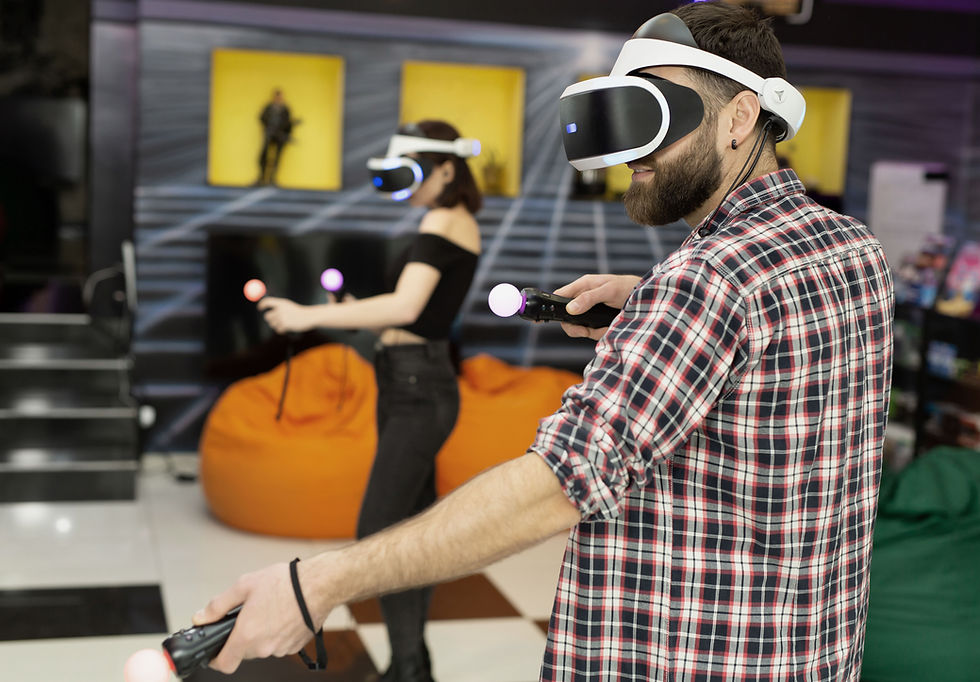The Future is Mixed: Oculus and Apple Lead the Charge in AR/VR Innovation
- Amit Chai

- Jun 7, 2023
- 3 min read
Updated: Jul 15, 2023

The field of augmented reality (AR) and virtual reality (VR) has taken a significant leap forward with the introduction of innovative headsets by tech giants Oculus (now Meta) and Apple. These devices promise to blend the digital and physical worlds like never before, offering users an immersive experience that has the potential to revolutionize various sectors, including entertainment, education, and healthcare and VR Innovation.
Meta's Approach: The Oculus Line-Up
Meta, previously known as Facebook, has been a dominant player in the VR market for some time, having entered the field with its acquisition of Oculus back in 2014. The company has sold over 20 million headsets to date, with their most successful offering being the Oculus Quest line. The most recent addition to this line is the Meta Quest 3, which comes at a significantly cheaper price point of $499. Unlike Apple's headset, the Quest 3 has a strong focus on gaming and is backwards compatible with apps and games designed for the Quest 2【10†source】.
Apple's Answer: The Vision Pro
Apple has recently unveiled its first major foray into the VR/AR market, the Vision Pro headset. This device represents Apple's approach to "spatial computing", a blend of VR and AR technologies. The Vision Pro comes with a hefty price tag of $3,499, positioning it in the premium segment of the market【7†source】【16†source】.
The Vision Pro has dual M2 and R1 chipsets to handle regular software and its XR capabilities. It offers a 4K resolution per eye and uses an array of 12 cameras, five sensors, and six microphones to track hand and eye movements, as well as voice inputs, for interaction. Uniquely, it doesn't come with controllers and relies on an external battery pack that provides roughly two hours of usage【17†source】【19†source】.
The Fusion of AR and VR in Apple's Vision Pro
Apple's Vision Pro aims to fuse AR and VR into a seamless experience. While VR immerses users in a completely digital environment, AR overlays digital elements onto the real world. Through a combination of front-facing cameras and high-resolution displays, the Vision Pro will provide users with a "mixed reality" experience, allowing them to interact with both real and digital elements in their environment.
The Future of Development Content
The introduction of these mixed-reality headsets will undoubtedly shape the future of content development. Developers will be tasked with creating experiences that can transition smoothly between AR and VR, offering a new level of interactivity. Games, simulations, educational programs, and more will need to be designed with this new paradigm in mind.
Implications for the Medical Field
The healthcare industry stands to gain significantly from AR/VR technology. The Vision Pro, for example, could be used for medical training, allowing students to practice procedures in a risk-free, virtual environment. Furthermore, AR could be used in real-time during surgeries to provide surgeons with overlaid information, such as patient vitals or 3D models of the area being operated on.
Closing Thoughts
The VR/AR landscape is set to change dramatically with the introduction of these new devices. As Meta and Apple continue to innovate, it will be exciting to see the new applications and experiences that emerge in this evolving space.
Please note that as of now, there is no specific information available on how Apple's Vision Pro will switch between AR and VR, or what specific content development tools will be provided for it. Similarly, specific applications in the medical field are speculative at this point. The blog post draft provided is based on general trends and expectations from the AR/VR industry. More detailed information will likely emerge as these products get closer to launch and after they are available to the public.




At Pin-Up, you can have peace of mind knowing that your security and privacy are prioritized. The online casino uses state-of-the-art encryption technology to secure all transactions and personal information. The casino https://pbase.com/nijazkekilli/image/174225793 also employs independent auditors to ensure that the games are fair and free of manipulation.
Pin-Up is designed to offer a user-friendly and convenient interface that makes it easy for you to navigate and use the online casino. The website is easy to understand, and the games are grouped into categories, making it easier to find your preferred games. Additionally, the casino supports multiple payment options, allowing you to choose the most convenient option.